Welcome to the official wiki for the game “Great Houses of Calderia”. This is the ultimate resource for all things related to this fascinating Feudal Grand Strategy game, where noble families vie for power, engage in diplomacy, and forge their legacies in the province of Calderia.
About the Game
Great Houses of Calderia is an immersive strategy experience that takes inspiration from the Mediterranean Renaissance.
Players step into the shoes of a noble family, aiming to rise through the ranks, extend their influence, and claim the throne of the power-hungry Viceroy.
Dive into a world of family dynamics, intricate diplomacy, and real-time tactical battles as you build your legacy of power.
Explore the rich lore of Calderia, shape your family’s destiny, and discover endless stories in this captivating and strategic game.
Note: This wiki is a community effort. Please ensure your contributions are accurate and respectful.
5 Tips on How to Start
1. Know your characters like the back of your hand
In Calderia, you aren’t just a ruler; you’re a leader managing an entire family. Each family member has a unique personality, traits, and desires. Take the time to understand their strengths and weaknesses, and assign them to roles that best suit their abilities. Keep in mind that characters’ personalities can evolve, shaped by the events they experience.
Lastly, pick the right family member to manage your fiefdom’s key operations to bolster your production and maintain the people´s happiness high!
Effective management of your family members is key to your success.
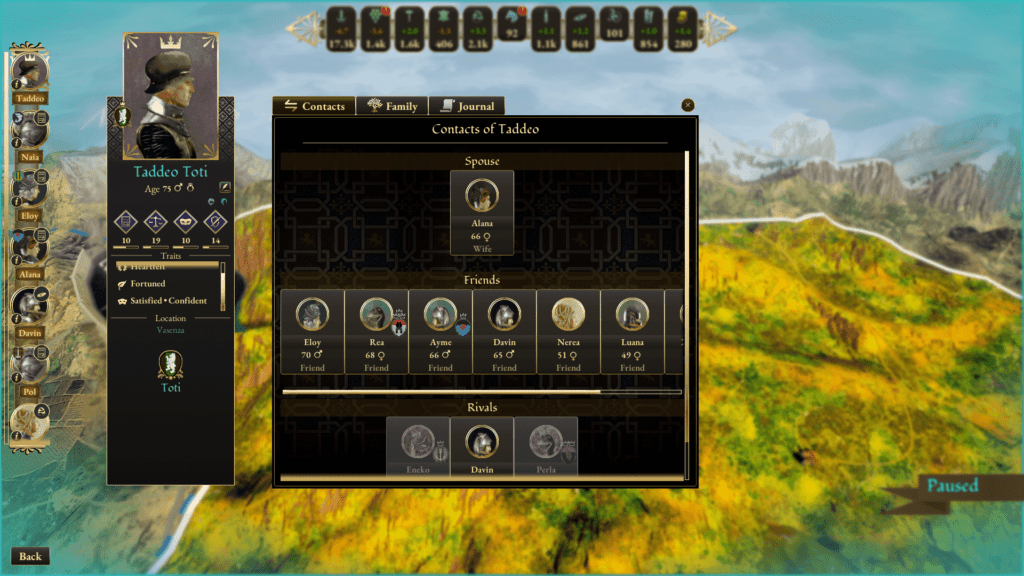
2. Balance Diplomacy, Strategy & Economy
Calderia isn’t just about battles on the field; it’s a realm where wise schemes, thriving economies, and diplomatic prowess are just as crucial. Utilize a delicate balance of diplomacy, intrigue, and trade to expand your influence. Make critical decisions during diplomatic events and battles alike, as these moments can shape the tide of power in your favour.
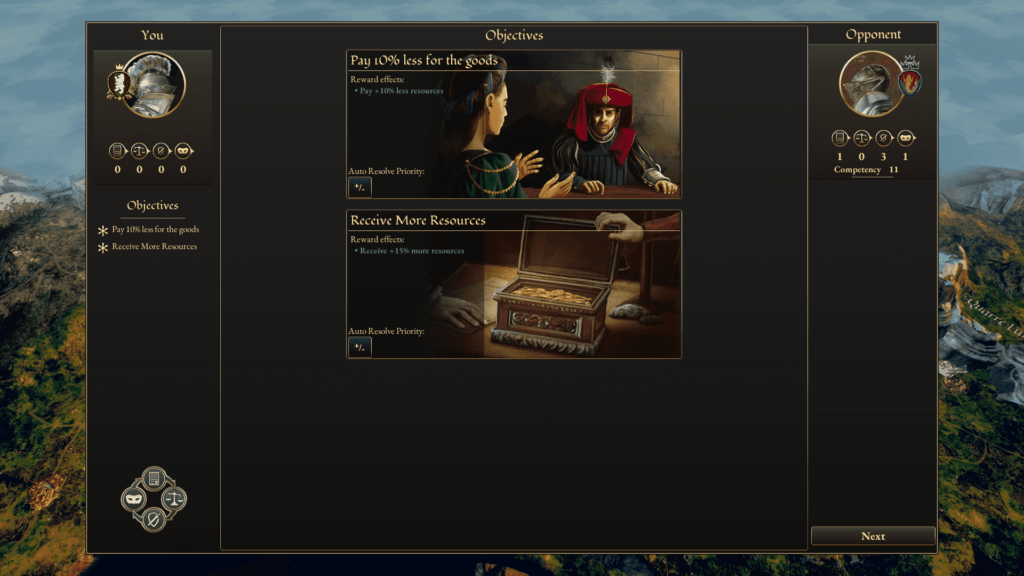
3. Embrace Real-time Tactical Battles
When it comes to securing victory, battles are inevitable. Engage in real-time tactical battles that require careful planning and execution. Manage your units effectively on the battlefield to outmanoeuvre your opponents and claim victory. Remember, however, that battles are just one aspect of securing new titles and ascending the ranks of Calderia’s hierarchy.
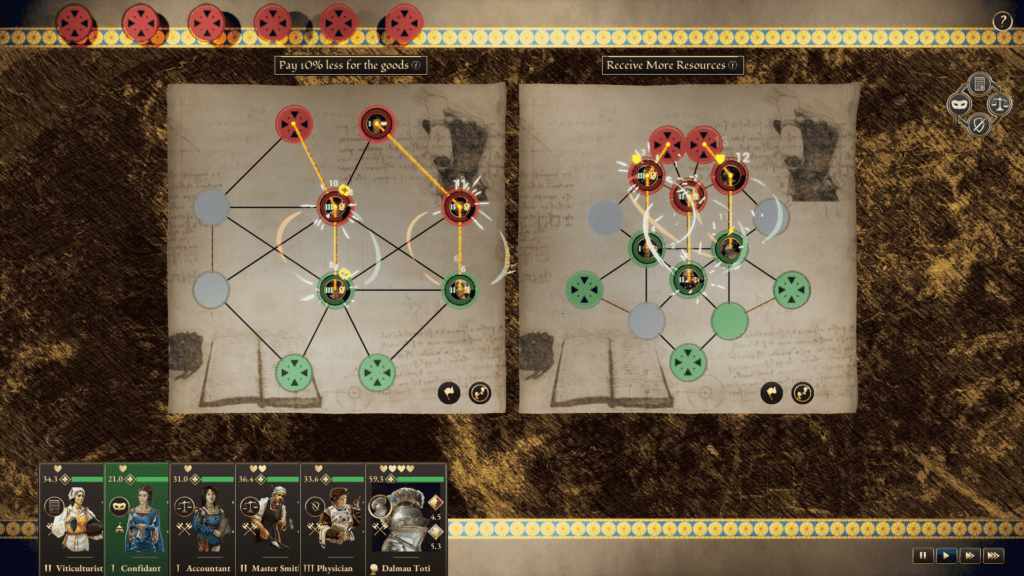
4. Shape Your Family’s Legacy
Define the traditions, values, and goals of your family. These elements are the foundation of your legacy and the story you’ll weave throughout the game. As you progress, you will experience the personal stories of your extended family, seeing your reputation grow and your influence expand. With the modding tool provided, you can even create unique, captivating narratives that further enrich the world of Calderia.

5. How to acquire new Agents & Units
The pool of Agents & Units is linked to the infrastructure.
Upgrading your region will not only increase your maximum Population and boost your production but also give you access to unique Agents that can help you in social conflicts or new Unit Types that can be recruited during wartime.
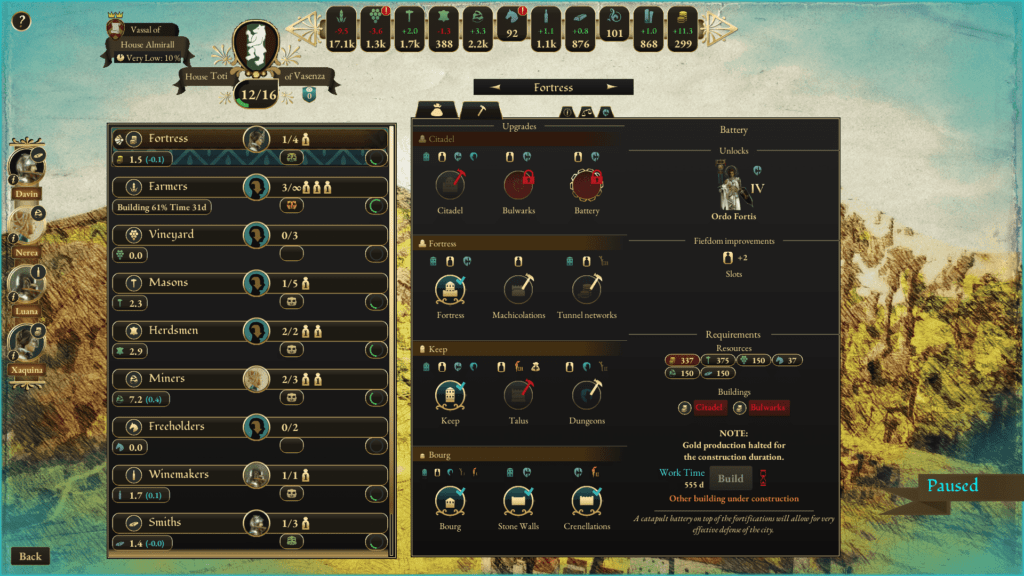
In conclusion, Great Houses of Calderia offers you an immersive experience in the complex world of Feudal Grand Strategy. By understanding your characters, mastering the art of diplomacy and strategy, embracing tactical battles, shaping your family’s legacy, and adapting to the ever-changing landscape, you can rise from a fledgling noble family to seize the throne and achieve the ultimate goal of becoming the power-hungry Viceroy of Calderia.
Good luck on your journey to dominion!
Traditions

- Peacemakers | faster population growth
- Idealists | easier to maintain happiness
- Warriors | better units
- Isolationists | level of safety is higher
- Schemers | level of intrigue is better
- Scholars | upgrades are cheaper
House origins

- Flatlands | high population & crops bonus
- Hillside | Crafters unlocked
- Mountain Range | Materials and Ore bonus
- Steppe | Varied effects
Fashion of Calderia
To bring this world to life, we undertook extensive research. We immersed ourselves in the historical era, studying everything from clothing to architecture, art, and culture.
This diligent research allowed us to develop an intuitive understanding of the era, which would later help us in our creative choices.
Moreover, we explored not only real-world historical sources but also drew inspiration from other fantasy realms set in similar time periods.
Games like Warhammer Fantasy, The Witcher, and Dungeons & Dragons served as valuable references, but we still aimed to find our own touch.
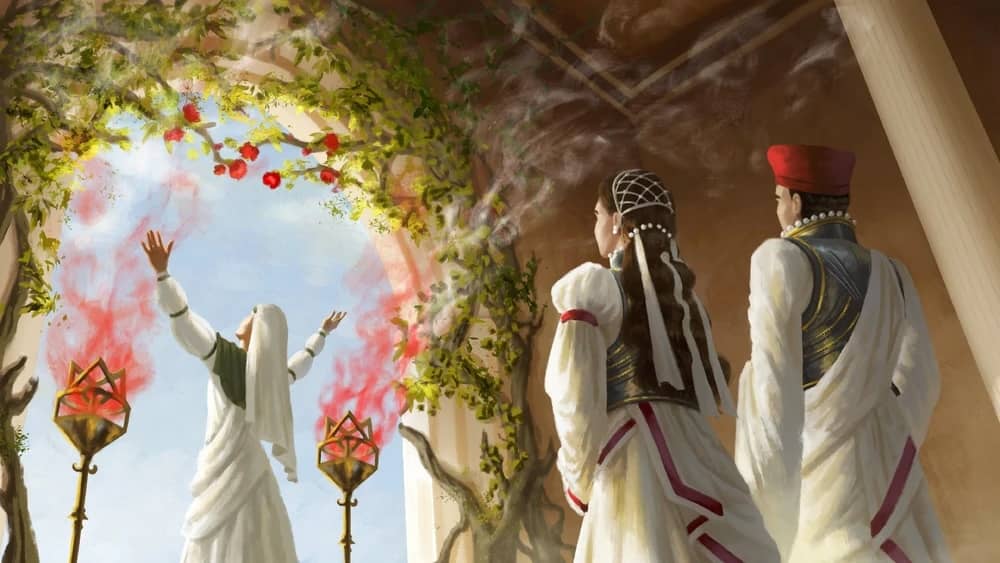
Intuitive sketching & exploration
One of the key creative processes in fashion design for Calderia involved intuitive sketching. We aimed to produce as many drawings as possible without imposing strict limitations.
This freedom to explore different styles and directions allowed us to establish the essence of Calderian fashion.
It was essential to explore the wrong paths as well, as this enabled us to better understand the surrounding styles and ultimately led to the one that felt right to us.
Examples
approved sketches with interesting mood & style

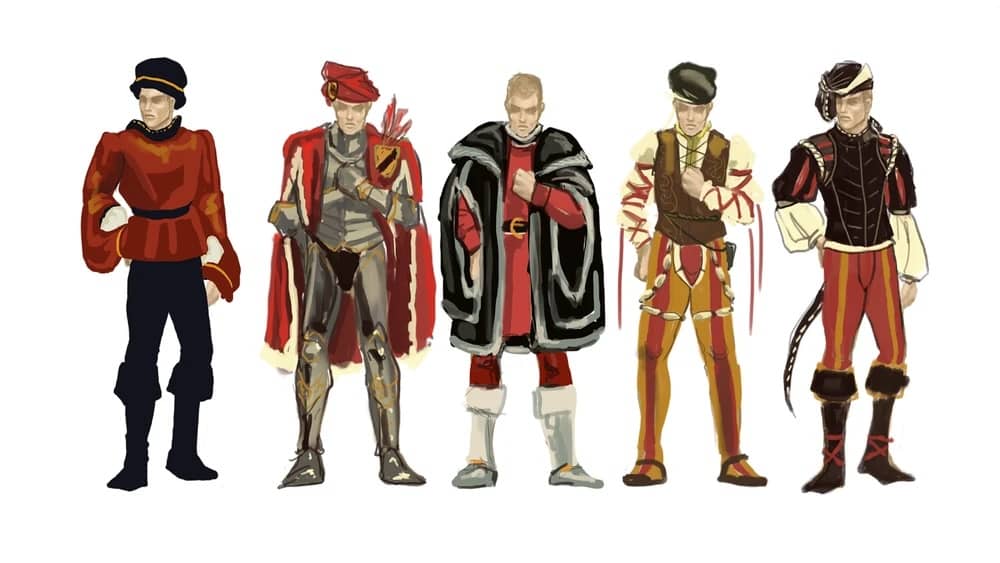
disapproved sketches which didn’t fit our vision
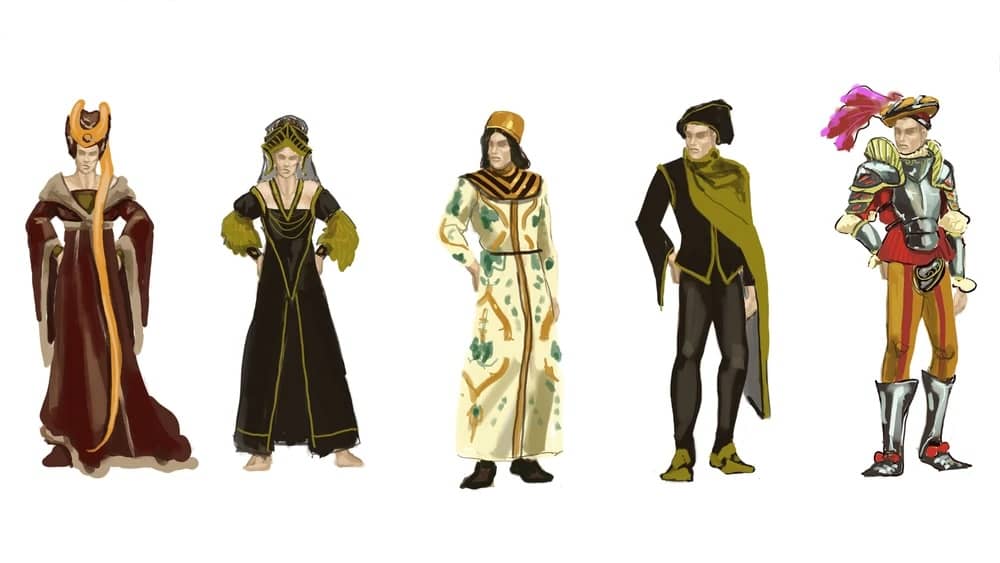
Chosen art direction: Italian & Spanish Renaissance
After extensive research and exploration, we settled on a fashion direction that drew heavily from Italian and Spanish influences. Our focus spanned from the Late Medieval to the Early Renaissance, with hints of the High and Late Renaissance, particularly in Italy.
We deliberately avoided the more commonly portrayed British, French, Burgundian, and German styles, seeking to establish a unique identity for Calderian fashion.
Armour pieces integrated with court dresses became a prominent feature, signifying the noble status of characters in the game. This deviated from historical accuracy, as in Renaissance Italy, wearing armour was considered dangerous, as one would be then likely “looking for problems”.
However, it was a deliberate choice to emphasize the Calderians’ interest in armours, and how they could be used to show off the quality of craftsmanship and the wealth of their fiefdoms.
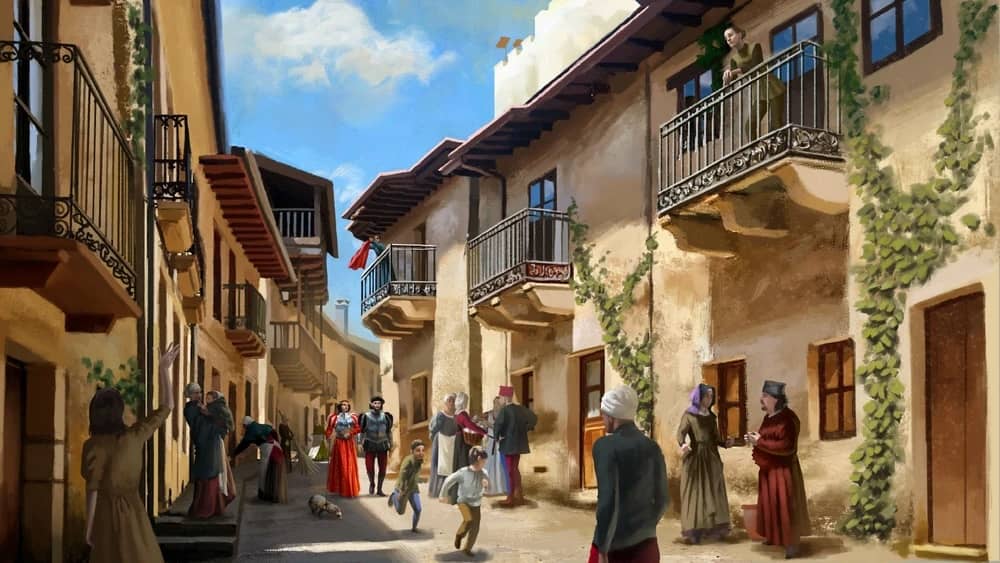
Blending History & fantasy
Finding a balance between low fantasy and history posed an interesting challenge for us.
We strived to explore historical components and take them slightly further towards fantasy. Elements such as gorgets and bevors, elaborate hairstyles, the extravagant use of pearls, and unique hats all contributed to the fantastical aspect of Calderian fashion.
The game’s roots in ancient mythology are reflected in religious attire and ceremonies, blending with modern Renaissance garments.
This fusion adds depth to the world, contributing to building the history and culture of Calderia based on a unique tapestry woven from various sources of inspiration.
Examples
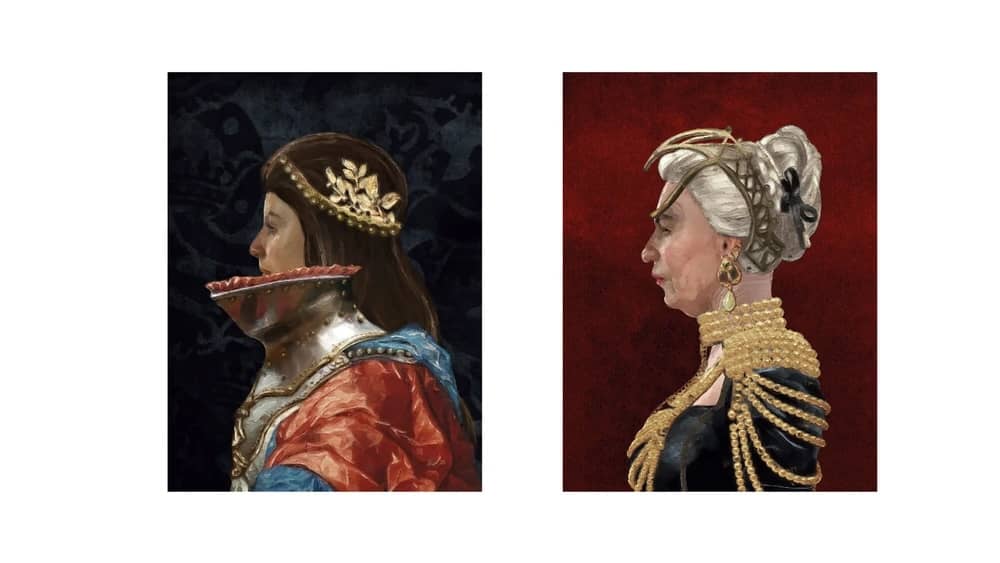
Imperial distinction
The presence of the Imperial overlords is rare in Calderia, but when it does happen, it is unmistakable.
Their style is a blend of Medieval and High Renaissance influences, leaning toward the British, French, and Burgundy styles that are consciously avoided in Calderian fashion.
Layering of opulent fabrics, the use of fur and leather, and a penchant for gloves all serve to distinguish the Imperial elite and show their wealth.
Examples
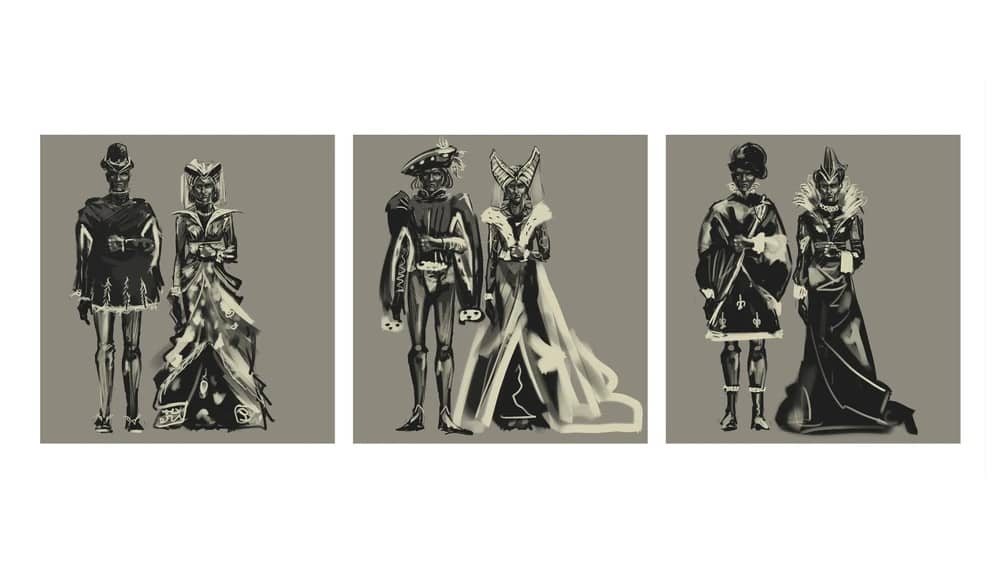
Calderian fashion is a visual exploration of History and fantasy, a uchronia that nurtures our creativity.
You can find more information about the art of Calderia in our art book.
Military
We delve into the intricate art of war, linked with diplomacy and economy, in Great Houses of Calderia. War is motivated by the influence of feudal politics and the pursuit of nobility ranks in Calderia.
Let’s explore the key features of how war works. There are specific steps and thresholds to meet the conditions for wars to be declared, they are shown at the war tooltip in military delegation view.
You must have negative relations with the House you want to attack.
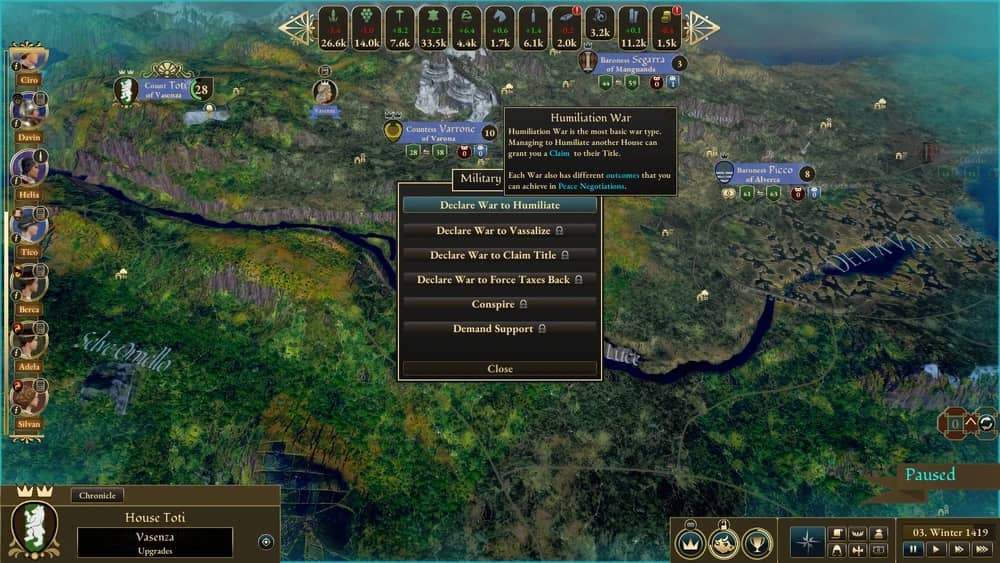
Here are the current war types and their requirements:
- Humiliation war: You must have House relations lower than -40. Winning this war allows you to either have a claim on their title or vassalize them.
- Vassalization war: You must have House relations lower than -60, have the right to vassalize and have a higher rank than the opposing House. Winning this war allows you to vassalize this House, which will then pledge allegiance and pay taxes to you.
- Title war: You must have House relations lower than -85, have the right to claim the title of the opposing House. Winning this war grants you the title of the defeated House, which will then go down to your previous title. For instance, you had the Baron rank before winning the Title War. The House you attacked had the Count rank, you then become a Count and they become a Baron.
- Tax war: This war can only be declared to vassals who are refusing to pay taxes they owe you. Winning this war will resume the tax payments the House owes you.
Units & warfare
Developing your fiefdom and making new buildings allows you to unlock new military units, each with its own unique strengths and roles on the battlefield.
Units come with both a raise cost and an upkeep cost, requiring you to balance your military might with your resources. All units have attack, defense, health and attack speed variables.
Some units can have special abilities that may be automatic, like ranged abilities, while others need to be activated.
Defense reduces attack damage input and the attacker also takes some damage. Military units, once engaged, are caught up in the battle and require time to retreat before they can escape the fight.
This adds dynamics to the ebb and flow of battles. Wounded units who managed to retreat in time join the reserve, where they can slowly heal so you can redeploy them again.
On the other hand, units who died during the fight cannot be used again for future battles during the ongoing war. With this game mechanic, we wanted to encourage a thoughtful rotation of troops to optimize your strategy.
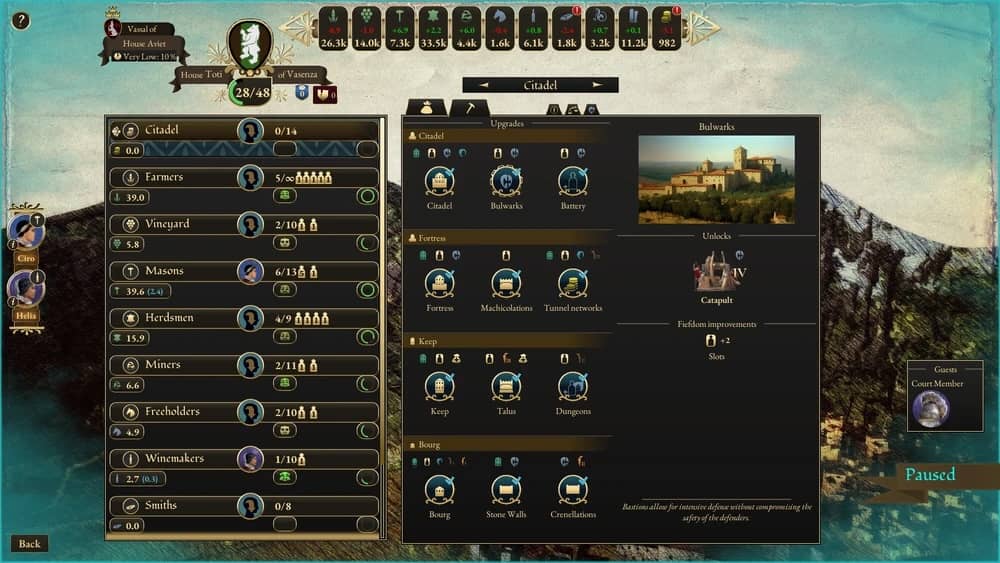
Rising in the nobility ranks
You must first successfully make a claim to a higher title to advance in nobility. Wars are an effective way to rise in the nobility ranks. They allow you to take over the title of the House ruling over you.
But first, you must declare and win a Humiliation War, then a Title War to obtain a new title. You can progress through nobility ranks one level at a time, from Baron to Count, Count to Duke, and from Duke to Viceroy.
Marriage is a powerful asset for forging alliances between the families tied by the union. These allies can then be called to join wars, strengthening your military power.
Growing your influence and military power starts at the court, the relationships you build are essential to your success.
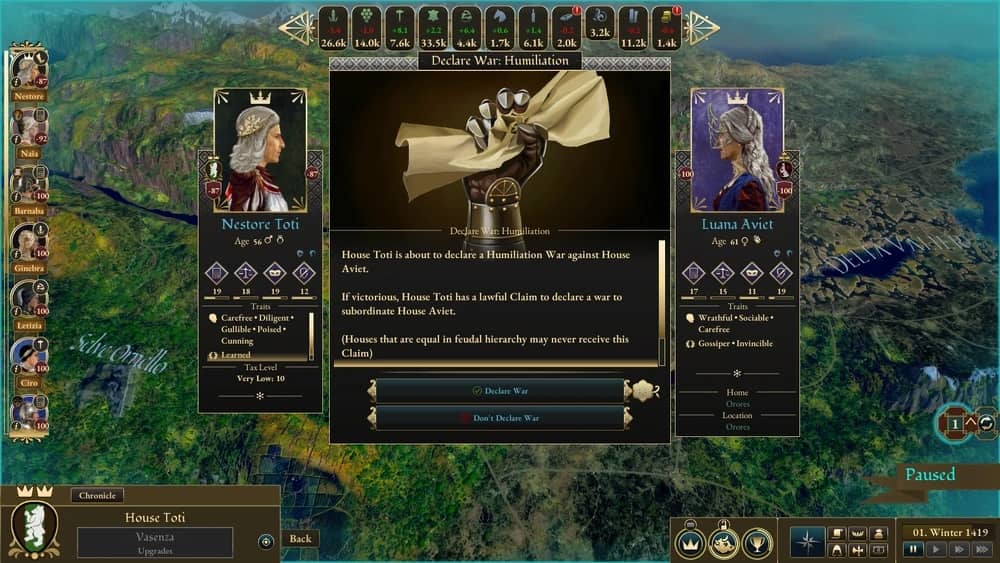
Peace negotiations & war weariness
Wars cannot last forever. Every war concludes with peace negotiations. The possible outcomes are determined by various elements based on how the war ended. It affects the terms that you can focus on during negotiations.
However, total wins and total losses have automatic outcomes. Engaging in war leads to war weariness that accumulates at varying levels, each with its own cumulative impacts. Successive wars also increase your war weariness.
War weariness takes time to wear off during peace, and peace treaties come with a truce period that prevents new wars from being declared right after a war ends.
Winning a war grants you an advantage in peace negotiations, as the losing party will have fewer companions to bargain with. Be aware that refusing ally calls to aid them in war degrades your reputation and strains relations with all the other Houses.
You have to balance your own interests with your reputation and relations with other Houses.
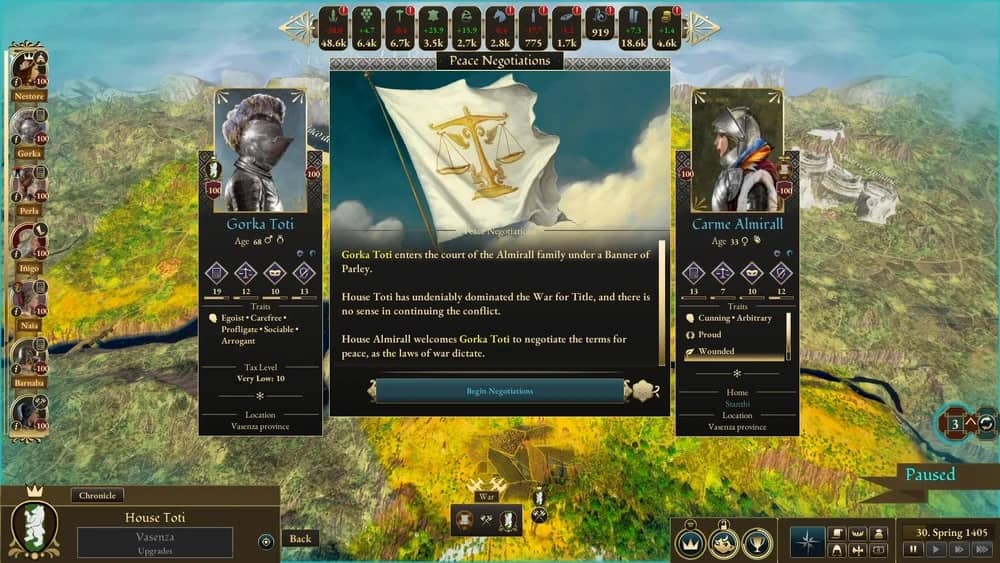
Resource management & war impact
Because resources like crops, livestock, materials, metal ore, horses, and grapes are produced outside the city, they are easy targets during war.
Blockades on roads to the city from resource locations disrupt the resource supply chain and prevent the fiefdom from receiving the resources.
On top of the blockades that can affect your resources and economic sustainability, enemy armies can burn down your production buildings that won’t produce resources until they are repaired.
Defending and repairing your production buildings is crucial to maintaining your ability to upkeep your armies.
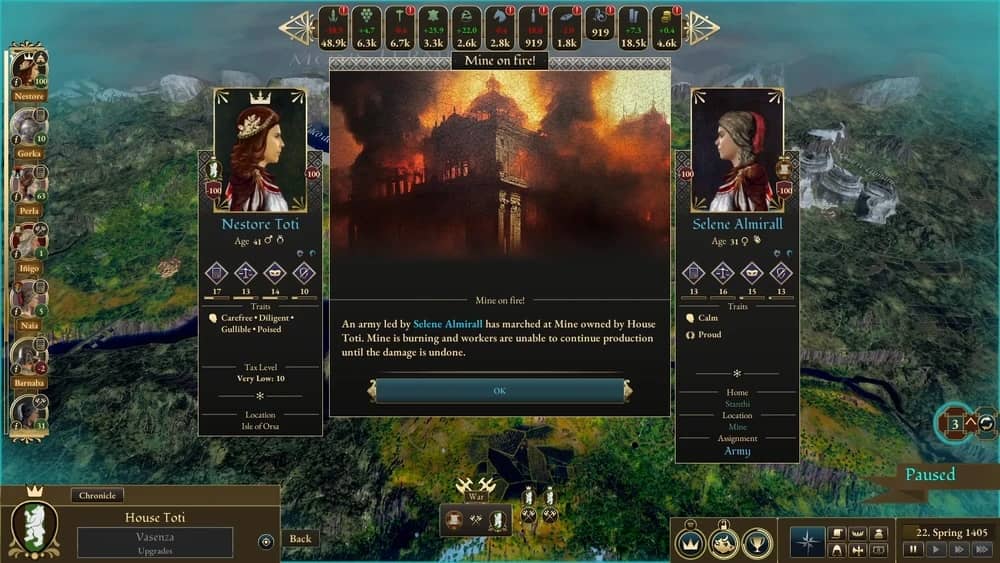
Siege & warscore
Losing a battle will have the remains of the army retreat automatically on the map for a while, giving a head start for the pursuing army. For now, siege has a static time period during which walls can be broken.
Conquering a castle grants a significant amount of points in the warscore, and maintaining a siege also accumulates additional points over time, which greatly contribute to victory.
All wars can end in five ways, from neutral peace to total victory or defeat, allowing for varied approaches depending on the most interesting outcomes for you.
Reaching neutral peace negotiations will result in both Houses seeking to earn something from the deal. Battlefields provide temporary effects for battles.
The warscore to aim for depends on the war type. Your tactical decisions should favor short and effective war resolutions rather than lengthy military conflicts.
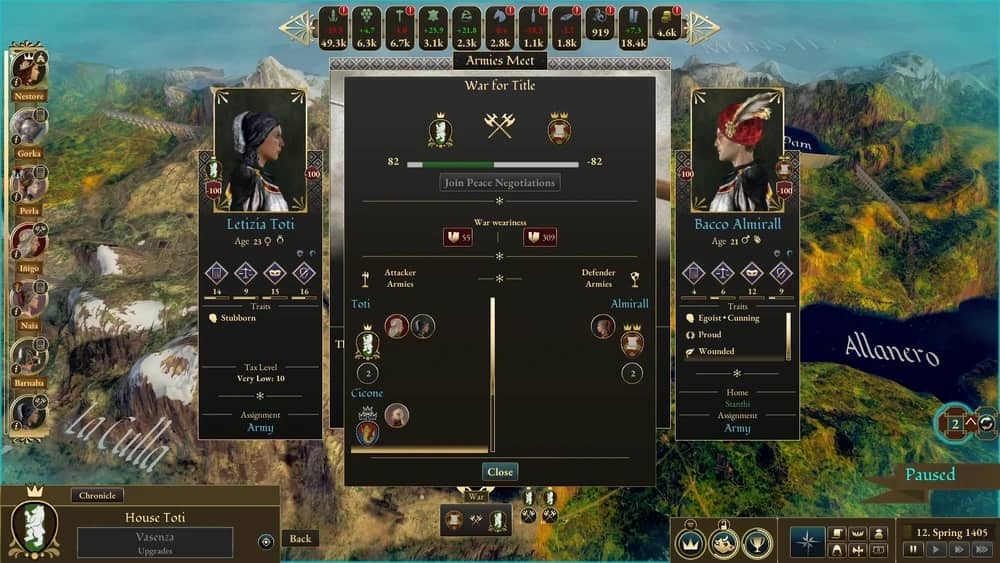
Now that we have tackled these features, giving you a better look at the way war works in the game, may you increase your chances of success and prevail with this knowledge. The complex art of military strategy, diplomatic and economic acuteness will shape the fate of your fiefdom.
May your banners fly high and your influence leave a lasting mark in the tapestry of power as you rise in the ranks of Calderia!
Resources

Green Resources are Basic Ressources | Blue-ish ones are the processed ones and will need basic ressources | Gold is a special item
- Grapes
- Materials
- Livestock
- Metal Ore
- Horses
- Wine
- Steel
- Luxuries
- Parchment
- Gold
Character Traits & Skills
D=Diplomacy | E=Economy | I=Intriuge | M=Military
| Traits | Bonus | Skill | Effekt |
|---|---|---|---|
| Altruist | D+2|E-1 | – | Lose all Health. Connected allies receive 50% more Health |
| Ambitious | M+1|E+1|D+1 | – | Target enemy unit is pushed back to a free slot, and this unit follows |
| Arbitary | D-2|E-1|M+3 | – | -0.5 to attack. Attacks all enemies connected to it simultaneously for 10 seconds |
| Arrogant | E-1 | – | Becomes invincible for 10 seconds to all others except the one it is attacking |
| Attractive | D+2 | – | Enemy has 10% less defence for 10 seconds |
| Benevolent | D+2|I-1 | – | Attack -0.5, defence +0.5, Health +50% |
| Blunt | M+1 | Active: Insult | Active: For 5 seconds, attack +1, defence -0.5 |
| Bridge-Builder | D+2 | – | This and target enemy both stop attacking for 10 seconds. |
| Calm | E+1 | – | For 5 seconds does not attack. For each attack that won’t take place, add the attack value to the next possible strike. |
| Carefree | E-1|D+1|M-1 | Passive: Blithe | Health +50% |
| Cautious | M-1 | Passive: Cautious | Attack -10, Defence +20, Morale -10 |
| Cruel | D-2|I+1 | Decapitate | Next attack will be calculated as +20. Enemy received -10 permanent penalty to morale. |
| Cunning | I+3 | Passive: Sly | Does not have disengaging status |
| Daring | M+2 | War Cry | Unit gets 10 second boost to attack value. As side effect, attracts all units that can to attack it. |
| Diligent | M+1|I+1|D+1 | – | – |
| Egoist | E-1 | Passive: I’m right | Attack +2, defence -1 |
| Eloquent | I-1 | – | All connected enemy units can’t attack for 5 seconds. |
| Fickle | I-1|E-1|M+1 | – | All units (enemies and allies) change positions with their targets in this playground. (Affects only connected units) |
| Forgiving | I-2 | Passive: Lenient | When in reserve, healing speed is 2x |
| Genius | M+2|D+2|E+2 | – | All nodes connected to this unit become conquered |
| Gentle | D+1 | – | All damage given and received by this unit, heal instead. Lasts for 10 seconds |
| Gullible | D+1 | – | Attack -1, defence -1, Health +25% |
| Humble | D+1 | Passive: Humble | Attack -0.5, Defence +1.5, Health +25% |
| Idiot | E-2|M-2|I-2 | Passive: Fool | Retreat & Draw enemy towards unit |
| Impatient | D-1|I+1 | – | Ignore “engaged in combat” restriction. Has +1 to attack for the first 3 seconds, after moving to a new slot. |
| Just | M+1 | – | – |
| Lazy | E-1|I-1|D-1 | Passive: Lazy | Speed -50%, Health +100%, Attack -1, Defence -1 |
| Melancholic | D-1 | Passive: Sullen | Morale +10 |
| Miser | E+3 | Active: Bargain | For 10 seconds, receive +2.5 to defence, but -1 to attack |
| Modest | E+1 | Passive: Low-key | Attack -0.5, defence +2 |
| Naive | I-3 | – | – |
| Poised | I+1 | Active: unpopular opinion, offensive remark | All connected enemies are locked to targeting you. Be invincible for the first 2 seconds. |
| Profligate | D+1 | Active: Bribe | Target enemy unit returns to reserve |
| Reckless | I-1 | Passive: Foolhardy | Morale +10, Attack +10, Defence -10 |
| Recluse | D-1 | Passive: Hermit | If connected opponents can target someone else, they do so. This lasts for 10 seconds. |
| Sceptic | D-1|E-1 | – | – |
| Sociable | D+2 | – | Attract all attacks to himself for 10 seconds. Everyone, including this, becomes invincible for that time. |
| Stubborn | M+2|D-1 | Bull-headed | Becomes invincible (doesn’t take damage) for 10 seconds. During this time halve the attack and defence skills for damage this causes. |
| Ugly | D-2 | Active: Repulsive | Lose all health. All units in this playground return to reserve (enemies and allies). |
| Vengeful | M+2|D-2 | Passive: Avenge! | For the next 10 seconds, get +5 attack and +5% health for every friendly unit that has died in this battle |
| Wary | M-2 | Passive: Wary | Attack -10, Defence +20 |
| Wrathful | M+3 | Zealous Anger | Can be activated when less than 50% health. For 10 seconds attack +10; health +25% |
